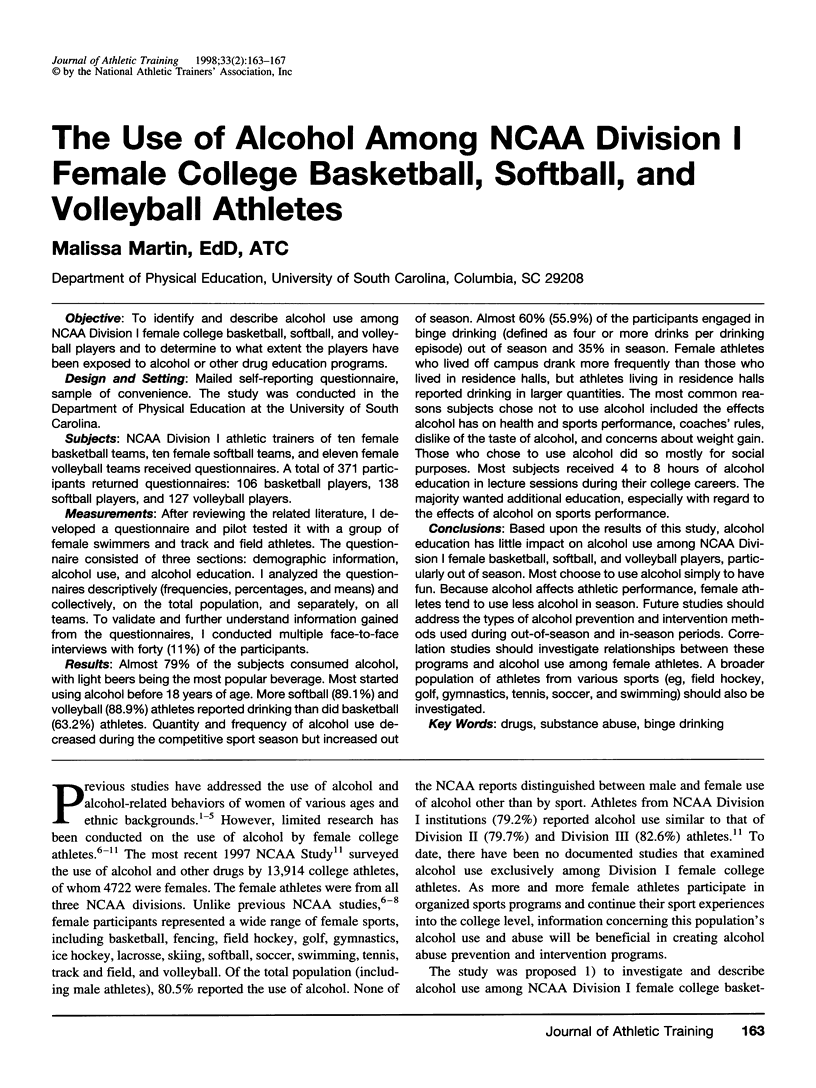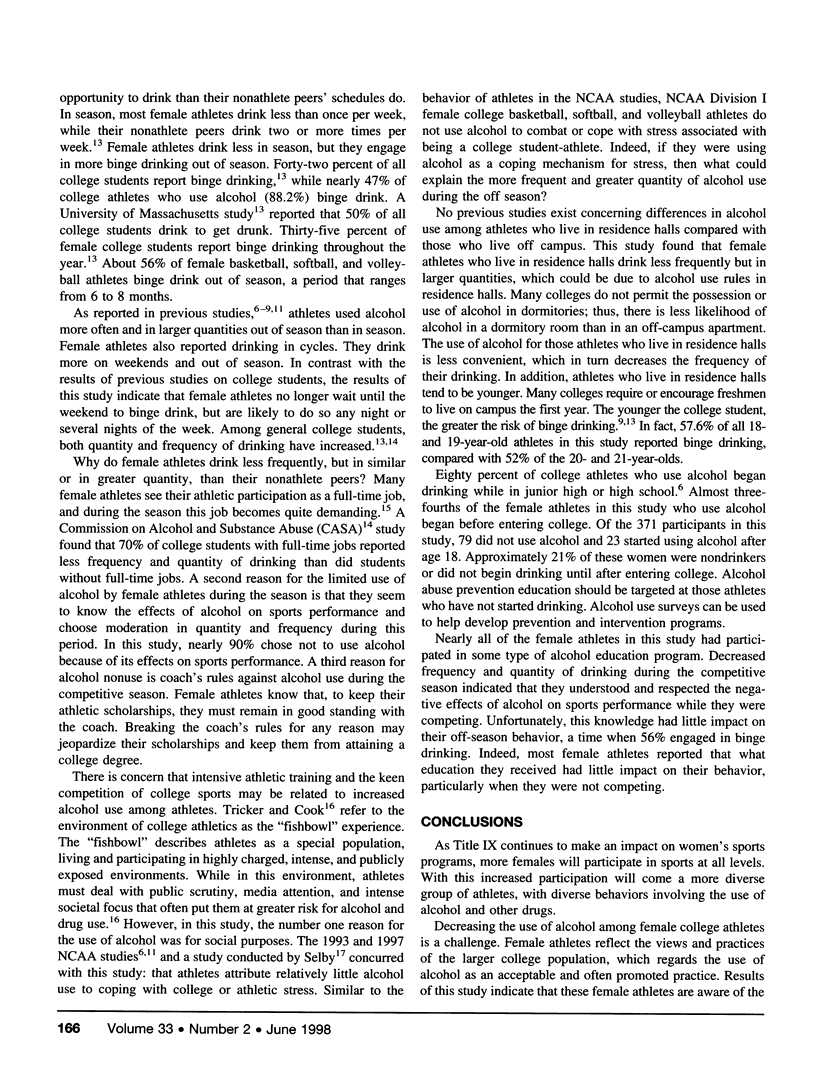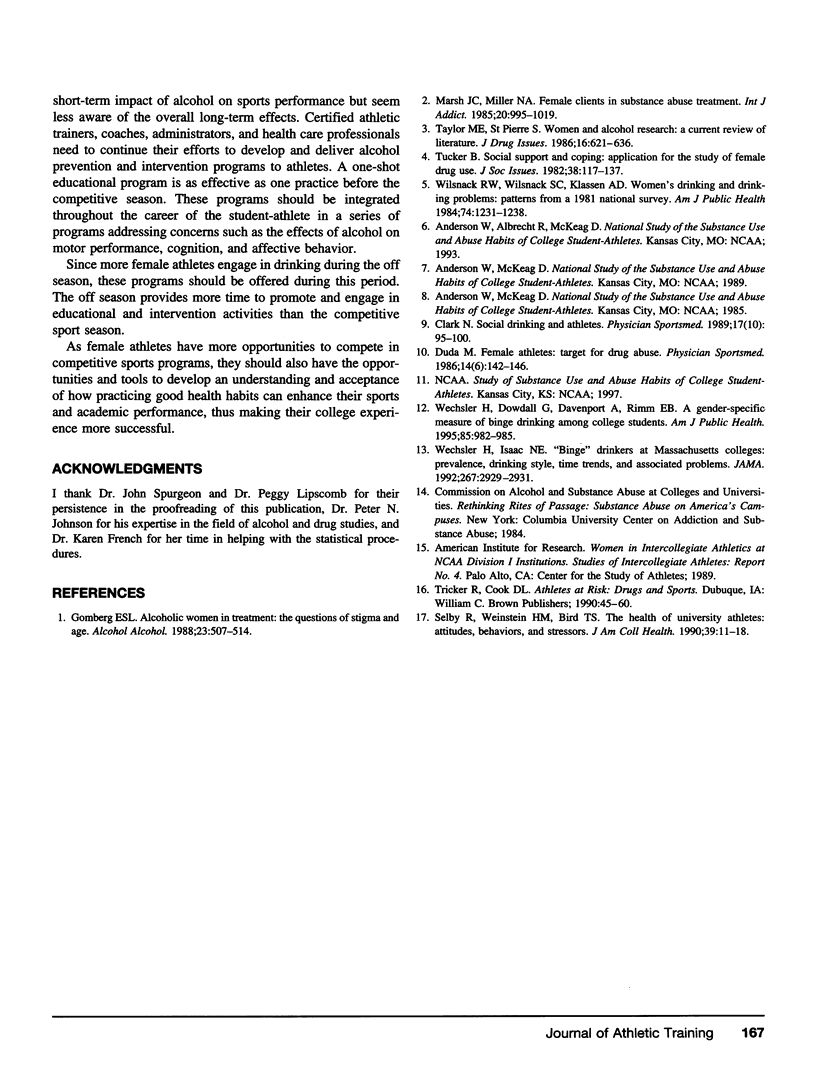Abstract
Objective:
To identify and describe alcohol use among NCAA Division I female college basketball, softball, and volleyball players and to determine to what extent the players have been exposed to alcohol or other drug education programs.
Design and Setting:
Mailed self-reporting questionnaire, sample of convenience. The study was conducted in the Department of Physical Education at the University of South Carolina.
Subjects:
NCAA Division I athletic trainers of ten female basketball teams, ten female softball teams, and eleven female volleyball teams received questionnaires. A total of 371 participants returned questionnaires: 106 basketball players, 138 softball players, and 127 volleyball players.
Measurements:
After reviewing the related literature, I developed a questionnaire and pilot tested it with a group of female swimmers and track and field athletes. The questionnaire consisted of three sections: demographic information, alcohol use, and alcohol education. I analyzed the questionnaires descriptively (frequencies, percentages, and means) and collectively, on the total population, and separately, on all teams. To validate and further understand information gained from the questionnaires, I conducted multiple face-to-face interviews with forty (11%) of the participants.
Results:
Almost 79% of the subjects consumed alcohol, with light beers being the most popular beverage. Most started using alcohol before 18 years of age. More softball (89.1%) and volleyball (88.9%) athletes reported drinking than did basketball (63.2%) athletes. Quantity and frequency of alcohol use decreased during the competitive sport season but increased out of season. Almost 60% (55.9%) of the participants engaged in binge drinking (defined as four or more drinks per drinking episode) out of season and 35% in season. Female athletes who lived off campus drank more frequently than those who lived in residence halls, but athletes living in residence halls reported drinking in larger quantities. The most common reasons subjects chose not to use alcohol included the effects alcohol has on health and sports performance, coaches' rules, dislike of the taste of alcohol, and concerns about weight gain. Those who chose to use alcohol did so mostly for social purposes. Most subjects received 4 to 8 hours of alcohol education in lecture sessions during their college careers. The majority wanted additional education, especially with regard to the effects of alcohol on sports performance.
Conclusions:
Based upon the results of this study, alcohol education has little impact on alcohol use among NCAA Division I female basketball, softball, and volleyball players, particularly out of season. Most choose to use alcohol simply to have fun. Because alcohol affects athletic performance, female athletes tend to use less alcohol in season. Future studies should address the types of alcohol prevention and intervention methods used during out-of-season and in-season periods. Correlation studies should investigate relationships between these programs and alcohol use among female athletes. A broader population of athletes from various sports (eg, field hockey, golf, gymnastics, tennis, soccer, and swimming) should also be investigated.
Keywords: drugs, substance abuse, binge drinking
Full text
PDF




Selected References
These references are in PubMed. This may not be the complete list of references from this article.
- Gomberg E. S. Alcoholic women in treatment: the question of stigma and age. Alcohol Alcohol. 1988;23(6):507–514. [PubMed] [Google Scholar]
- Marsh J. C., Miller N. A. Female clients in substance abuse treatment. Int J Addict. 1985 Jun-Jul;20(6-7):995–1019. doi: 10.3109/10826088509047762. [DOI] [PubMed] [Google Scholar]
- Selby R., Weinstein H. M., Bird T. S. The health of university athletes: attitudes, behaviors, and stressors. J Am Coll Health. 1990 Jul;39(1):11–18. doi: 10.1080/07448481.1990.9936208. [DOI] [PubMed] [Google Scholar]
- Wechsler H., Dowdall G. W., Davenport A., Rimm E. B. A gender-specific measure of binge drinking among college students. Am J Public Health. 1995 Jul;85(7):982–985. doi: 10.2105/ajph.85.7.982. [DOI] [PMC free article] [PubMed] [Google Scholar]
- Wechsler H., Isaac N. 'Binge' drinkers at Massachusetts colleges. Prevalence, drinking style, time trends, and associated problems. JAMA. 1992 Jun 3;267(21):2929–2931. doi: 10.1001/jama.267.21.2929. [DOI] [PubMed] [Google Scholar]
- Wilsnack R. W., Wilsnack S. C., Klassen A. D. Women's drinking and drinking problems: patterns from a 1981 national survey. Am J Public Health. 1984 Nov;74(11):1231–1238. doi: 10.2105/ajph.74.11.1231. [DOI] [PMC free article] [PubMed] [Google Scholar]


